BY JASON W. GREER
On the fireground, firefighters consider trapped civilians and how likely they are to survive the fire under given circumstances. Many of us have trained in some way to understand this as a civilian’s survivability profile, but how much do firefighters really think about their own fireground survival profile? Chances are not many of us have really done a gut self-check on where we truly stand and how well prepared we are to face that survival moment of truth.
Think of your fireground survival profile as akin to a body type. Hopefully, most of you are doing your part to maintain your profile regarding your personal fitness, but you know that’s not the case for everyone-many of us would love to have a well-toned and slender profile. From a firefighter survival or a rapid intervention team (RIT) perspective, your training stresses the importance of reducing your profile to enable you to navigate obstacles or free yourself from entanglements. In enhancing your rescue survival profile, you can remove unhealthy layers of ignorance and apathy, just as in enhancing your body profile you can remove unhealthy layers of fat if you put in the effort. As you read this article, check off each item about which you can honestly say, “Hey, I do that!” That’s another unhealthy layer you have shed.
SURVIVAL INVENTORY
As an instructor, I learn just as much from watching students’ actions and listening to their comments as I ever did as a student. Observing others performing the routine tasks and skill sets firefighters perform has really opened my eyes to some real world and real time feedback. In my opening comments for firefighter survival classes, I challenge the students to tell me what firefighter survival is. I hear things like, “It’s how to save ourselves” or “how to get out.” Those are good answers, I respond, but I ask students to dig further, and I get blank stares. We firefighters are great at describing the physical acts of firefighter survival (e.g., head-first ladder bailouts, window bailouts and rope slides, navigating entanglement hazards, reduced profile moves, and calling the Mayday). It’s all great, and I’m always happy to hear members discuss these key points. But I reinforce the point that your survival is based on core fundamentals and understanding what is right in front of you and often what you have on. Your survival is directly linked to the basic training, the tools, and the equipment you use every day. Take an inventory of your own survival profile. Following is a discussion of some common items you use all the time and how enhancing your knowledge of them will help you return home from each call and improve your survival profile.
TURNOUT GEAR
Many firefighters put on their turnout gear and never think twice about it. They know it’s supposed to protect them and it’s supposed to be worn properly at all times, but they can’t say much more than what color it is and how hot and annoying it is during the summer. This is the first line of defense and, on average, many firefighters know very little about it. At a minimum, you should at least know the manufacturer-stated thermal ratings and how to properly inspect and clean the garment. You don’t have to know thread and stitch counts, but you should at least realize your gear has multiple layers that are removable. We all know a firefighter who always has the dirtiest gear on the rack. If you truly care about your survival as well as that of others, you will ensure that your gear is cleaned often. Heavily soiled turnout gear is a legitimate safety concern. On more than one occasion, I’ve witnessed firefighters wash their gear by simply throwing the entire set in the station extractor, considering it a job well done.
Wait a minute! Take the extra time to separate the liners, inspect them, and wash them separately. When the gear has been washed, also be sure to put it back together the proper way. I can’t tell you how many times I’ve seen firefighters start to wash their gear and discover their drag rescue device for the first time, hold it up, and ask why it’s in their gear. This is scary in itself; what’s even worse is that the same people remove the device, have no clue how to reinstall it, and make the conscious decision to just leave it out altogether. Although it is not as exciting as bailing head-first out of a window, knowing your turnout gear inside and out is a crucial first step in increasing your survival profile.
I tell entry-level firefighters to find their own groove when it comes to their turnout gear. Consistency is key when donning turnout gear. Develop a routine that works for you to ensure you don’t omit essentials like hoods and gloves. Do it the same way every time, and it will be impossible for you to forget simple things like your hood and gloves. Conversely, I caution members about adding too many items to their turnout gear. Items that hang or attach to the outside of gear can quickly become entanglement hazards and add extra weight. We all know that member who has every gizmo and gadget on the market that snaps, hangs, or retracts all over his gear-usually the same member who gets stuck or hung up at every reduced profile training and can never figure out what the problem is. In this case, reducing these extra items actually increases your chances of survival.
SCBA
Hands down, your self-contained breathing apparatus (SCBA) is one of the most important pieces of equipment you use routinely, so ask yourself how well you really know what you’re strapping to your back. You had better be inspecting your SCBA at the beginning of each shift. Even if you are relieving your best friend or a family member, check it! It takes only a few minutes and can make the difference in whether you go home at the end of your shift. Some argue that this is tough to do among volunteers, which may be correct to a point. But there is no reason that you cannot do a quick check on the way to a call and even more so when you arrive on scene. I promise this can be done so you’re not wasting precious time (photo 1).
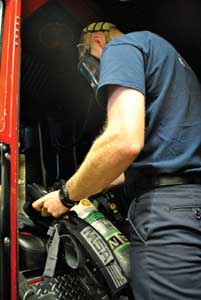 |
| (1) A firefighter checks his SCBA on arrival at the scene. (Photos by Woody Woodward.) |
For most modern SCBA, you have at least three points at which to check your air supply before committing to interior operations. Hopefully, after a quick self-quiz, you were able to fire off the answers right away. If you didn’t, train on your SCBA now, and find them! They are the shoulder gauge, the heads-up display, and the cylinder valve. Understandably, it is tough to do this alone, but have someone in your crew take a quick peek-it may just save your life. Be certain you know every blinking light, beep, boop, ding, ring, vibration, and alarm your SCBA has and what it means. Understanding the difference between a low-battery and a thermal exposure alert is a big deal, as is understanding the lights and flash patterns in your heads-up display.
One exercise I use to drive home this point is to have students draw their SCBA and label all the parts and identify their colors. They should at least be able to identify the various components by name and location. To really drive this home, I ask them to draw a picture of the SCBA’s personal alert safety system (PASS) device and to be specific when it comes to naming the PASS button location, shape, and color. Another helpful trick is to randomly ask students to quickly activate their PASS devices. Many times, they will reach for the wrong side or press the wrong button multiple times. In this moment, you can be a mentor and ensure your firefighters understand the value of the following: understanding and training on SCBA emergency procedures, quickly troubleshooting an air issue, using your emergency bypass or purge valve, and ducking and covering your face piece to filter breath. All these should be second nature. Practice these skills until you can’t get them wrong.
Finally, train your firefighters to wear the SCBA as it is intended. The waist belts are there for a reason. I know it may not look as cool to wear them, but from a survival viewpoint, you’re much less likely to get snagged or hung up on an object if you properly wear your waist belt. Also, you will also be more productive in your work by allowing the SCBA to ride on your hips rather than tightening them on your shoulders and restricting your range of motion. From the RIT standpoint, it makes life much easier to do an SCBA conversion if the belt is already in place.
RADIOS
Always carry a portable radio to enhance your survival profile. In recent years, many departments have beefed up the number of radios so every rider can carry one for instant fireground communication. Many also take the portable radio for granted, yet it is one of the most important tools for ensuring fireground survival. As with the SCBA, you must know how to operate this radio as well as you do your cell phone or the firehouse TV remote. Ideally, your department should have a radio training program that thoroughly explains the radio’s operation and proper wording of communications over your radios, particularly the Mayday call. Schedule at least an annual training session to sit down at a table and discuss the specific radio model itself. Point out and explain what every button does. Simulate a situation in which you are unable to get to your radio normally-e.g., when your arm is pinned behind your back. You may be amazed with the results, and it may very well lead to additional discussion points and training sessions. As with the SCBA, you need to understand what every chirp, buzz, click, and squawk means and be able to manipulate the radio while wearing structural firefighting gloves. Consider implementing a yearly check sheet that confirms a firefighter’s competency in several areas, ranging from switching channels to activating any emergency trigger buttons and announcing your department’s Mayday procedure over the air. Keeping your skills sharp on these items will certainly prove helpful in a fireground emergency.
THERMAL IMAGING CAMERAS
Thermal imaging cameras (TICs) are now on almost every piece of fire apparatus; many departments have more than one TIC on each rig. TICs are great tools, but a few key things have to happen for them to enhance your survival profile. First and foremost, you must carry the TIC with you. You should know the rule that you do not get off the rig without a tool in your hand. If your rig is equipped with a TIC, make sure someone is assigned to bring it.
Grabbing the TIC’s spare battery is another key item. For many TICs, the spare battery is right on the same charger as the TIC. Take the extra two seconds to grab the spare and put it in an easily accessible pocket with a gloved hand and be able to swap out the batteries using gloved hands, too. Practice doing this in reduced visibility until you can’t get it wrong. You should train with the TIC on various levels.
Interpreting what you are looking at accurately is paramount, as is the understanding that you are not “seeing through smoke.” If your TIC is equipped with multiple modes, you must be able to switch between them easily and understand the difference between each image. For example, you should know the difference between the high- and low-sensitivity settings within the TIC. The brand of TIC carried on several of the rigs in my department will switch modes when a certain temperature is reached, indicated by the changing color of text and icons on the screen. Why is this important? If the color changes, fire conditions are changing and temperatures are rising even though you may not yet feel it. Take the time to understand how your TICs really work and what the screen is telling you. Remember, TICs are tools and do not make you invincible. Always be sure to stay true to your basic search techniques and patterns. You can’t go wrong with a right- or left-hand search, and you will never have to worry about the battery going dead (photos 2, 3).
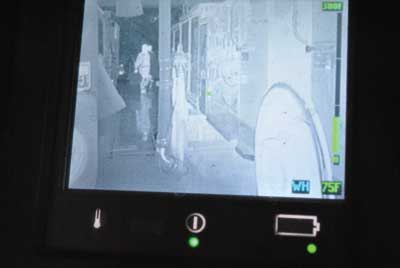 |
| (2) Know your tools and their operation indicators. For this manufacturer’s thermal imaging camera (TIC), the normal 75°F temperature displays in green at lower right. The battery life indicator changes from green to yellow to red to indicate diminishing power. Note the “white-hot” (“WH”) indicator. |
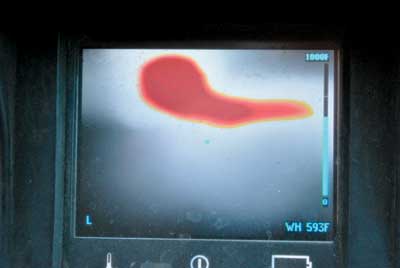 |
| (3) Note the text color is now blue, the temperature is 593°F, and an “L” (lower sensitivity mode) has appeared at the lower left-all of which indicate temperatures are rising. For this TIC model, the display color becomes blue at about 300°F. Understand that your surroundings are rapidly changing. |
SHIFT CHANGE
Completing a simple task like the apparatus check at shift change can play a huge factor not only for you but also for your entire crew’s survivability. In addition to all the items already discussed, a simple once-over of the rig will allow you to be yet another step ahead for survivability. Open each compartment, make sure all equipment is there, and confirm that all power equipment is properly fueled and running well. If you are assigned to ride the line seat, look at your handlines and nozzles. Check all the fog nozzles and make sure they are already set in the straight stream position; double check to see that all the lines are packed correctly and will easily deploy (photo 4). For the truck company, make sure your irons are in good shape and all surfaces are well maintained. Make certain the water can is full and properly pressurized and all the saws are ready to go with the proper chain and blades on them. Go over your ladders to be sure they are all in good working order so you are not faced with any surprises at three o’clock in the morning when you have people trapped on the second and third floors. Taking the extra time at the beginning of your shift will save you from a possible catastrophe later on.
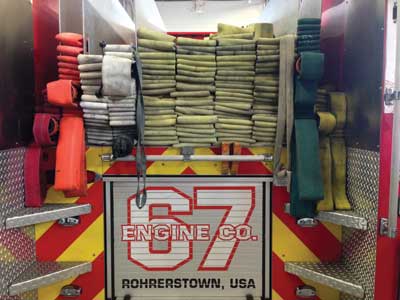 |
| (4) These lines are packed for easy deployment. |
ASSIGNMENT
Know your assignment and all the associated tasks that go with it. In times of reduced staffing and doing more with less, not being prepared is unacceptable and, quite honestly, irresponsible. If you’re assigned to be the driver/operator, I’d fully expect that you know the rig and all of its capabilities. If you’re an engine company member, it’s not unreasonable for people to expect you to know how to pull and rerack every line on your rig. Truck company personnel should be able to recite the location and function of each piece of equipment on the truck. You had better know your ground ladder complement and how to place ladders most efficiently on a fire building. Simply marking your ladder complement helps make that 2:00 a.m. rescue of an upper-floor occupant happen just a few seconds faster. You don’t have to guess which is the 35-foot and which is the 28-foot ladder (photo 5). I can’t shout it loud enough-KNOW YOUR JOB!
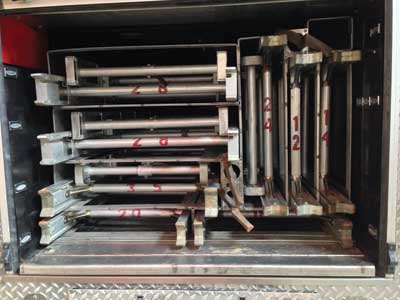 |
| (5) Marked ladders eliminate having to guess on the fireground. |
HEALTH
The statistics are all over and we are reminded every day that the number one cause of firefighter line-of-duty deaths is cardiac emergencies, yet we continue to lose firefighters at an alarming rate. Fitness is one of the easiest ways we can increase our survival profile. Firefighters are responsible to maintain a level of fitness. Not all of us will be on the cover of a health and fitness magazine, but we must at least be willing to get off the chair and take a step in the right direction. There are many ways to achieve a higher fitness level, and most of it starts in the kitchen. Even some simple step like walking around the station a few times can be the catalyst to jump-start a healthier lifestyle. Many departments have in-station workout equipment; those that don’t still have a gold mine of items lying around to use. Simply using equipment in the station such as spare hose, turnout gear, SCBA, traffic cones, ladders, sledgehammers, and so on can make for an amazing circuit workout that can be tailored to all fitness levels. Look on the Internet for some great examples of firefighter-specific circuit workouts. These sites have some great ideas, and you don’t have to worry about getting anything passed through a budget meeting to make it happen.
Hopefully, you can begin to see what a solid survival profile looks like. It isn’t fancy-it should include all those items you are already doing. If you reviewed the items above and are honest with yourself, you will see whether you’re prepared for a full-blown survival situation. This can be a good gut check for you to review some basic skills and equipment knowledge as well.
Prepare yourself, and train hard on the basics. Program yourself to be consistent with the most fundamental tasks, and refine your skills so you can perform them under adverse conditions.
JASON W. GREER is a lieutenant in the Lancaster City (PA) Bureau of Fire, assigned to Engine Company 3, and a 19-year veteran of the fire service. He is a Pennsylvania State Fire Academy adjunct instructor and delivers local-level fire programs for several community colleges. Greer is a member of the state’s South Central Task Force, serving as a deputy operations section chief on the incident management team, and has national certifications for fire officer, fire instructor, incident safety officer, and rescue technician.
Fire Engineering Archives

